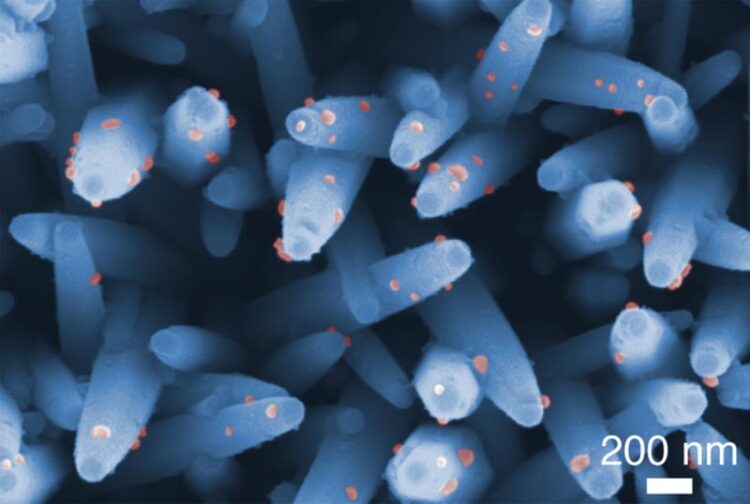Scientists develop new device to detect brain tumors using urine

Microscopic image of nanowires
Credit: Dr Takao Yasui
Researchers at Nagoya University in Japan have used a new device to identify a key membrane protein in urine that indicates whether the patient has a brain tumor. Their protein could be used to detect brain cancer, avoiding the need for invasive tests, and increasing the likelihood of tumors being detected early enough for surgery. This research could also have potential implications for detecting other types of cancer. The research was published in ACS Nano.
Although early detection of many types of cancer has contributed to the recent increases in cancer survival rates, the survival rate for brain tumors has remained almost unchanged for over 20 years. Partly this is due to their late detection. Physicians often discover brain tumors only after the onset of neurological symptoms, such as loss of movement or speech, by which time the tumor has reached a considerable size. Detecting the tumor when it is still small, and starting treatment as soon as possible. should help to save lives.
One possible sign that a person has a brain tumor is the presence of tumor-related extracellular vesicles (EVs) in their urine. EVs are nano-sized vesicles involved in a variety of functions, including cell-to-cell communication. Because those found in brain cancer patients have specific types of RNA and membrane proteins, they could be used to detect the presence of cancer and its progression.
Although they are excreted far from the brain, many EVs from cancer cells exist stably and are excreted in the urine without breaking down. Urine testing has many advantages, explains Associate Professor Takao Yasui of Nagoya University Graduate School of Engineering. “Liquid biopsy can be performed using many body fluids, but blood tests are invasive,” he said. “Urine tests are an effective, simple, and non-invasive method because the urine contains many informative biomolecules that can be traced back to identify the disease.”
A research group led by Yasui and Professor Yoshinobu Baba of Nagoya University’s Graduate School of Engineering, in collaboration with Nagoya University’s Institute of Innovation for Future Society and the University of Tokyo, has developed a new analysis platform for brain tumor EVs using nanowires at the bottom of a well plate. Using this device, they identified two specific types of EV membrane proteins, known as CD31/CD63, from urine samples of brain tumor patients. Looking for these tell-tale proteins could enable doctors to identify tumor patients before they develop symptoms.
“Currently, EV isolation and detection methods require more than two instruments and an assay to isolate and then detect EVs,” said Yasui. “The all-in-one nanowire assay can isolate and detect EVs using one simple procedure. In the future, users can run samples through our assay and change the detection part, by selectively modifying it to detect specific membrane proteins or miRNAs inside EVs to detect other types of cancer. Using this platform, we expect to advance the analysis of the expression levels of specific membrane proteins in patients’ urinary EVs, which will enable the early detection of different types of cancer.”
Journal: ACS Nano
DOI: 10.1021/acsnano.2c08526
Article Title: All-in-one nanowire assay system for capture and analysis of extracellular vesicles from an ex vivo brain tumor model
Article Publication Date: 19-Jan-2023
Media Contact
Matthew Coslett
Nagoya University
kouho-en@adm.nagoya-u.ac.jp
Office: +81 (0)52-747-6862
@NagoyaUniv
All latest news from the category: Life Sciences and Chemistry
Articles and reports from the Life Sciences and chemistry area deal with applied and basic research into modern biology, chemistry and human medicine.
Valuable information can be found on a range of life sciences fields including bacteriology, biochemistry, bionics, bioinformatics, biophysics, biotechnology, genetics, geobotany, human biology, marine biology, microbiology, molecular biology, cellular biology, zoology, bioinorganic chemistry, microchemistry and environmental chemistry.
Newest articles

NASA: Mystery of life’s handedness deepens
The mystery of why life uses molecules with specific orientations has deepened with a NASA-funded discovery that RNA — a key molecule thought to have potentially held the instructions for…

What are the effects of historic lithium mining on water quality?
Study reveals low levels of common contaminants but high levels of other elements in waters associated with an abandoned lithium mine. Lithium ore and mining waste from a historic lithium…

Quantum-inspired design boosts efficiency of heat-to-electricity conversion
Rice engineers take unconventional route to improving thermophotovoltaic systems. Researchers at Rice University have found a new way to improve a key element of thermophotovoltaic (TPV) systems, which convert heat…



